Afantas c our
Page 26
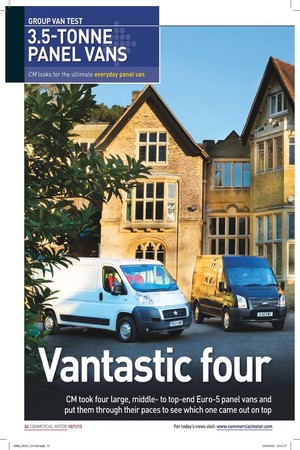
Page 27
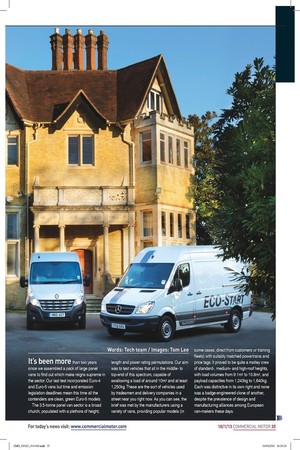
Page 28
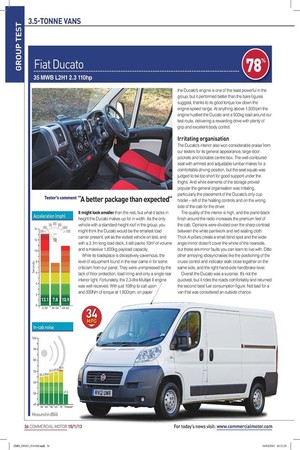
Page 29
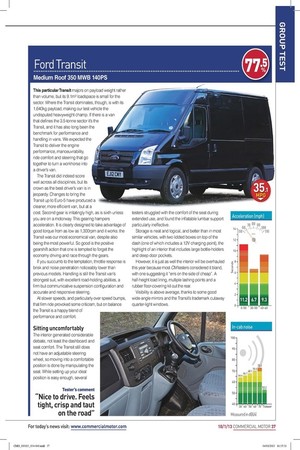
Page 30

Page 31
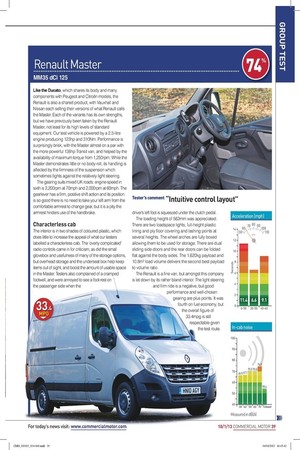
Page 32

Page 33
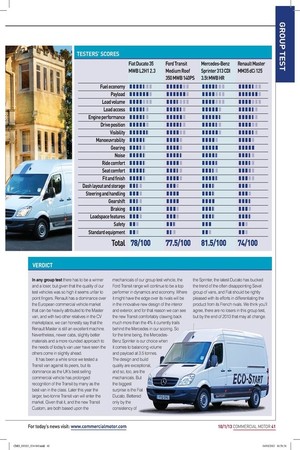
If you've noticed an error in this article please click here to report it so we can fix it.
CMO 100113 034-041.indd 34 Words: Tech team / Images: Tom Lee It's been more than two years since we assembled a pack of large panel vans to find out which make reigns supreme in the sector. Our last test incorporated Euro-4 and Euro-5 vans but time and emission legislation deadlines mean this time all the contenders are clean, green Euro-5 models.
The 3.5-tonne panel van sector is a broad church, populated with a plethora of height, length and power rating permutations. Our aim was to test vehicles that sit in the middleto top-end of this spectrum, capable of swallowing a load of around 10m3 and at least 1,250kg. These are the sort of vehicles used by tradesmen and delivery companies in a street near you right now. As you can see, the brief was met by the manufacturers using a variety of vans, providing popular models (in some cases, direct from customers or training fleets) with suitably matched powertrains and price tags. It proved to be quite a motley crew of standard-, mediumand high-roof heights, with load volumes from 9.1m3 to 10.8m3, and payload capacities from 1,243kg to 1,640kg. Each was distinctive in its own right and none was a badge-engineered clone of another, despite the prevalence of design and manufacturing alliances among European van-makers these days.
It might look smaller than the rest, but what it lacks in height the Ducato makes up for in width. As the only vehicle with a standard-height roof in the group, you might think the Ducato would be the smallest load carrier present, yet as the widest vehicle on test, and with a 3.1m-long load deck, it still packs 10m3 of volume and a massive 1,600kg payload capacity.
While its loadspace is deceptively cavernous, the level of equipment found in the rear came in for some criticism from our panel. They were unimpressed by the lack of floor protection, load lining and only a single rear interior light. Fortunately, the 2.3-litre Multijet II engine was well received. With just 108hp to call upon and 300Nm of torque at 1,800rpm, on paper the Ducato's engine is one of the least powerful in the group, but it performed better than the bare figures suggest, thanks to its good torque low down the engine-speed range. At anything above 1,500rpm the engine hustled the Ducato and a 500kg load around our test route, delivering a rewarding drive with plenty of grip and excellent body control.
Irritating organisation The Ducato's interior also won considerable praise from our testers for its general appearance, large door pockets and lockable centre box. The well-contoured seat with armrest and adjustable lumbar makes for a comfortable driving position, but the seat squab was judged to be too short for good support under the thighs. And while elements of the storage proved popular the general organisation was irritating, particularly the placement of the Ducato's only cup holder — left of the heating controls and on the wrong side of the cab for the driver.
The quality of the interior is high, and the piano-black finish around the radio increases the premium feel of the cab. Opinions were divided over the sharp contrast between the white paintwork and red seating cloth. Thick A-pillars create a small blind spot and the wideangle mirror doesn't cover the whole of the nearside, but these are minor faults you can learn to live with. Ditto other annoying idiosyncrasies like the positioning of the cruise control and indicator stalk close together on the same side, and the right-hand-side handbrake lever. Overall the Ducato was a surprise. It's not the quickest, but it rides the roads comfortably and returned the second best fuel consumption figure. Not bad for a van that was considered an outside chance.
This particular Transit majors on payload weight rather than volume, but its 9.1m3 loadspace is small for the sector. Where the Transit dominates, though, is with its 1,640kg payload, making our test vehicle the undisputed heavyweight champ. If there is a van that defines the 3.5-tonne sector it's the Transit, and it has also long been the benchmark for performance and handling in vans. We expected the Transit to deliver the engine performance, manoeuvrability, ride comfort and steering that go together to turn a workhorse into a driver's van.
The Transit did indeed score well across all disciplines, but its crown as the best driver's van is in jeopardy. Changes to bring the Transit up to Euro-5 have produced a cleaner, more efficient van, but at a cost. Second gear is irritatingly high, as is sixth unless you are on a motorway. This gearing hampers acceleration. It is clearly designed to take advantage of good torque from as low as 1,300rpm and it works: the Transit was our most economical van, despite also being the most powerful. So good is the positive gearshift action that one is tempted to forget the economy driving and race through the gears.
If you succumb to the temptation, throttle response is brisk and noise penetration noticeably lower than previous models. Handling is still the Transit van's strongest suit, with excellent road-holding abilities, a firm but communicative suspension configuration and accurate and responsive steering.
At slower speeds, and particularly over speed bumps, that firm ride provoked some criticism, but on balance the Transit is a happy blend of performance and comfort.
Sitting uncomfortably The interior generated considerable debate, not least the dashboard and seat comfort. The Transit still does not have an adjustable steering wheel, so moving into a comfortable position is done by manipulating the seat. While setting up your ideal position is easy enough, several testers struggled with the comfort of the seat during extended use, and found the inflatable lumbar support particularly ineffective.
Storage is neat and logical, and better than in most similar vehicles, with two lidded boxes on top of the dash (one of which includes a 12V charging point), the highlight of an interior that includes large bottle-holders and deep door pockets.
However, it is just as well the interior will be overhauled this year because most CM testers considered it bland, with one suggesting it "errs on the side of cheap". A half-height load lining, multiple lashing points and a rubber floor-covering kit out the rear.
Visibility is above average, thanks to some good wide-angle mirrors and the Transit's trademark cutaway quarter-light windows.
An ever-present on our motorways, the Sprinter's ability to cover the miles is well known. The fact that it does so in such a relaxing manner is testament to the design and engineering that underpins this van.
The Sprinter's interior is both appealing and fit for purpose, combining hardwearing plastics with functional design to create the best cab of the group.
Aspects singled out for praise by our testers included the supportive seats, the amount of storage — particularly for paperwork — and the overall quality and tastefulness of the interior.
The high-roof model we tested has several large overhead storage areas and, unlike its rivals, the Sprinter also has under-seat storage.
Simple features like this, and little touches such as making the cup-holder adjustable for size, contribute to an interior that is the most practical of the five.
Any niggles are minor, such as the major speedometer markings at 20mph, 40mph and 60mph instead of a more logical 30mph, 50mph and 70mph.
Impressive loadspace Moving on to the loadspace area, the Sprinter gets multiheight lashing points and a non-slip floor covering, but our testers were more impressed by its internal lighting, with no fewer than three lights to illuminate the darkest recesses. On the road, you would never believe that the Sprinter's engine is the smallest of our group.
The 2,143cc unit puts out 127hp at 3,800rpm but it is the torque that is more impressive, with 305Nm available from just 1,200rpm until 2,400rpm. Mercedes adjusted the ratios in the six-speed gearbox to suit the Euro-5 engine, so maximum torque is available pretty much all the time at almost every road speed, and the engine feels strong and unstressed.
In its natural habitat at 70mph in the third lane of a motorway, engine speed is around 2,200rpm and the Sprinter feels relaxed.
Our noise readings confirm that it is the quietest vehicle on test at that speed.
In the view of our testers, the Sprinter out-scored the Transit on engine performance, manoeuvrability, ride comfort and steering, confirming that the Sprinter (at this size and weight, at least) performs and handles better than all its rivals. It was mid-table in terms of fuel economy.
Finally, and as a footnote on the quality of the Sprinter, at least two of our testers commented on the steadiness of the speedometer and rev-counter needles. A strange observation perhaps, but one that does convey the air of quality that this van exudes.
Like the Ducato, which shares its body and many components with Peugeot and Citroen models, the Renault is also a shared product, with Vauxhall and Nissan each selling their versions of what Renault calls the Master. Each of the variants has its own strengths, but we have previously been taken by the Renault Master, not least for its high levels of standard equipment. Our test vehicle is powered by a 2.3-litre engine producing 123hp and 310Nm. Performance is surprisingly brisk, with the Master almost on a par with the more powerful 138hp Transit van, and helped by the availability of maximum torque from 1,250rpm. While the Master demonstrates little or no body-roll, its handling is affected by the firmness of the suspension which sometimes fights against the relatively light steering.
The gearing suits mixed UK roads: engine-speed in sixth is 2,200rpm at 70mph and 2,000rpm at 60mph. The gearlever has a firm, positive shift action and its position is so good there is no need to take your left arm from the comfortable armrest to change gear, but it is a pity the armrest hinders use of the handbrake.
Characterless cab The interior is in two shades of coloured plastic, which does little to increase the appeal of what our testers labelled a characterless cab. The 'overly complicated' radio controls came in for criticism, as did the small glovebox and usefulness of many of the storage options, but overhead storage and the underseat box help keep items out of sight, and boost the amount of usable space in the Master. Testers also complained of a cramped footwell, and were annoyed to see a foot-rest on the passenger side when the driver's left foot is squeezed under the clutch pedal.
The loading height of 562mm was appreciated. There are two loadspace lights, full-height plastic lining and ply floor covering and lashing points at several heights. The wheel arches are fully boxed allowing them to be used for storage. There are dual sliding side doors and the rear doors can be folded flat against the body sides. The 1,620kg payload and 10.8m3 load volume delivers the second best payload to volume ratio.
The Renault is a fine van, but amongst this company is let down by its rather bland interior. The light steering and firm ride is a negative, but good _ performance and well-chosen gearing are plus points. It was fourth on fuel economy, but the overall figure of 33.4mpg is still respectable given the test route.
SPECIFICATIONS Make and model Fiat Ducat° 35 MWB L2H1 2.3 Ford Transit Medium Roof 350 MWB 140P5 Mercedes-Benz Sprinter 313 CDI 3.5t MWB HR Renault Master MM35 dCi 125 Price (basic] £22,295 £25,370 £27,644 £24,420 Engine 2,287cc, 108hp1a3,600rpm, 300Nm(a1,800rpm, turbodiesel, 189g/km CO2 2,198cc, 138hp1a3,500rpm, 350Nm(a1,450rpm, turbodiesel, 209g/km CO2 2,143cc, 127hp1a3,800rpm, 305Nm(a1,200rpm-2,400rpm turbodiesel, 222g/km CO2 2,298cc, 123hp1a3,500rpm, 310Nm(a1,250rpm-2,500rpm, turbodiesel, 205g/km CO2 Transmission Six-speed manual Six-speed manual Six-speed manual Six-speed manual Driveline FWD FWD RWD FWD Payload (kg] 1,600 1,640 1,243 1,620 Load volume (ms] 10 9.1 10.5 10.8 Vehicle length (mm] 5,413 5,230 5,910 5,548 Width (mm] [exc mirrors] 2,050 1,974 1,993 2,070 Height (mm] 2,254 2,397 2,700 2,499 Loadspace length (mm] 3,120 2,949 3,265 3,083 Loadspacewidth (mm] 1,870 1,762 1,736 1,765 Loadspace height (mm] 1,662 1,745 1,940 1,894 Width between wheelarches (mm] 1,422 1,390 1,350 1,380 Loading height 460 596 666 562 Wheelbase (mm] 3,450 3,300 3,665 3,682 FUEL ECONOMY Miles per gallon 34 35.1 33.8 33.4 VERDICT In any group test there has to be a winner and a loser, but given that the quality of our test vehicles was so high it seems unfair to point fingers. Renault has a dominance over the European commercial vehicle market that can be heavily attributed to the Master van, and with two other relatives in the CV marketplace, we can honestly say that the Renault Master is still an excellent machine. Nevertheless, newer cabs, slightly better materials and a more rounded approach to the needs of today's van user have seen the others come in slightly ahead.
It has been a while since we tested a Transit van against its peers, but its dominance as the UK's best selling commercial vehicle has prolonged recognition of the Transit by many as the best van in the class. Later this year the larger, two-tonne Transit van will enter the market. Given that it, and the new Transit Custom, are both based upon the mechanicals of our group test vehicle, the Ford Transit range will continue to be a top performer in dynamics and economy. Where it might have the edge over its rivals will be in the innovative new design of the interior and exterior, and for that reason we can see the new Transit comfortably clawing back much more than the 4% it currently trails behind the Mercedes in our scoring. So for the time being, the MercedesBenz Sprinter is our choice when it comes to balancing volume and payload at 3.5 tonnes. The design and build quality are exceptional, and so, too, are the mechanicals. But the biggest surprise is the Fiat Ducato. Bettered only by the consistency of the Sprinter, the latest Ducato has bucked the trend of the often disappointing Sevel group of vans, and Fiat should be rightly pleased with its efforts in differentiating the product from its French rivals. We think you'll agree, there are no losers in this group test, but by the end of 2013 that may all change.









































